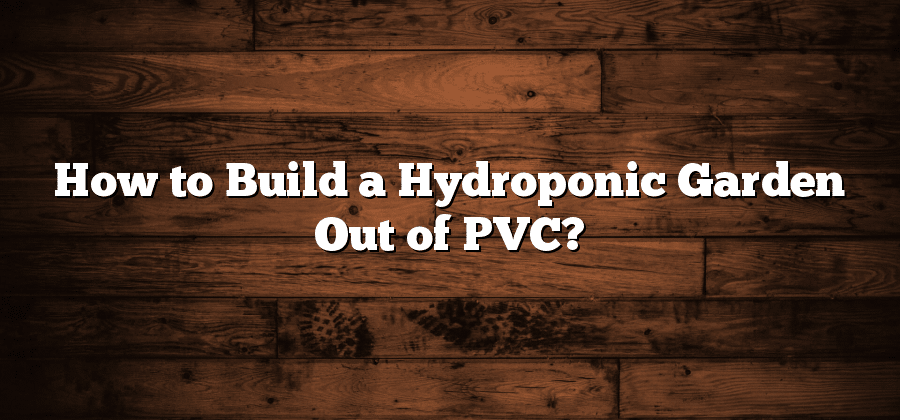Understanding the Benefits of Hydroponic Gardening with PVC
Hydroponic gardening has gained significant popularity in recent years due to its numerous benefits. One of the key advantages of using PVC pipes in hydroponic systems is their affordability and accessibility. Unlike traditional gardening methods that require extensive land, soil, and fertilizers, hydroponic gardens with PVC pipes can be set up in any indoor or outdoor space. PVC materials are readily available in most hardware stores, making it easy for anyone to start their own hydroponic garden.
Another benefit of hydroponic gardening with PVC is the enhanced control over nutrient delivery to plants. In traditional gardening, nutrients are absorbed by plants through their roots from the soil. However, in hydroponics, the plants are grown in an inert medium, such as perlite or coco coir, and a nutrient-rich water solution is delivered directly to their roots. This allows for a more efficient absorption of nutrients, resulting in healthier and faster-growing plants. Additionally, the use of PVC pipes in hydroponic systems allows for precise control of water and nutrient delivery, ensuring that plants receive the optimal amount of nutrients at all times.
Choosing the Right PVC Materials for Your Hydroponic Garden
When it comes to setting up a hydroponic garden using PVC pipes, choosing the right materials is crucial for the success of your project. PVC, or polyvinyl chloride, is a popular choice due to its durability, affordability, and ease of use. However, not all PVC pipes are created equal, and it is important to select the appropriate materials for your specific hydroponic system.
Firstly, you need to consider the diameter of the PVC pipes. The size of the pipes will depend on the scale of your hydroponic garden and the types of plants you intend to grow. Smaller diameter pipes, such as 1/2 inch or 3/4 inch, are suitable for smaller systems or plants with shallow root systems. On the other hand, larger diameter pipes, such as 1 inch or 1 1/2 inch, are better suited for larger systems or plants with deeper root structures. It is important to match the pipe diameter with your specific needs to ensure proper water flow and nutrient distribution.
Secondly, you should pay attention to the quality of the PVC pipes. Look for pipes that are labeled as “schedule 40” or “schedule 80.” These grades of PVC are thicker and more robust, making them suitable for the constant exposure to water and nutrient solutions in hydroponic systems. Avoid using pipes labeled as “schedule 20” as they are less sturdy and may not withstand the pressure of the system. Additionally, always choose PVC pipes that are free from any defects or cracks to ensure the longevity of your hydroponic garden.
Designing Your Hydroponic System Using PVC Pipes
Designing a hydroponic system using PVC pipes requires careful planning and consideration. PVC pipes offer several advantages for hydroponic gardening, including their durability, affordability, and versatility. They are available in various sizes and can be easily customized to fit the specific needs of your hydroponic setup.
Before you begin designing your hydroponic system, it is important to determine the size and scale of your garden. Consider factors such as the available space, the number of plants you want to grow, and the types of crops you plan to cultivate. This information will help you determine the number and length of PVC pipes required, as well as the layout and configuration of your hydroponic system. Additionally, you need to carefully plan the location and arrangement of other components such as grow beds, nutrient reservoirs, and water pumps. By considering these factors in the design phase, you can ensure that your hydroponic system using PVC pipes is efficient, effective, and optimized for plant growth.
Essential Tools and Equipment for Building a PVC Hydroponic Garden
To successfully build a PVC hydroponic garden, there are several essential tools and equipment that you will need. Firstly, a PVC pipe cutter is a must-have tool as it allows you to easily cut the PVC pipes to the desired lengths. This ensures precision and accuracy in fitting the pipes together.
In addition to the pipe cutter, you will also need PVC primer and cement. These products are used to securely bond the PVC pipes and fittings, creating a strong and watertight seal. It is important to choose a primer and cement that are specifically designed for use with PVC materials to ensure optimal results.
Step-by-Step Guide to Assembling and Installing PVC Pipes
To assemble and install PVC pipes for your hydroponic system, you will need a few essential tools and equipment. Firstly, gather a measuring tape, a pencil, a hacksaw, and PVC primer and cement. These will be crucial during the installation process. It’s important to double-check your measurements and mark the PVC pipes accordingly before cutting them with the hacksaw. Remember to measure twice and cut once to ensure accurate and precise lengths.
Once you have the correct lengths of PVC pipe, it is time to assemble them. Apply PVC primer to the outside of one end of the pipe and the inside of one end of the fitting. Next, do the same with PVC cement. Connect the primed ends together and give them a quarter turn to ensure a secure fit. Hold the pieces together for a few seconds to allow the cement to bond properly. Repeat this process for every joint in your PVC system. Remember to work quickly with the primer and cement, as they can dry fast.






